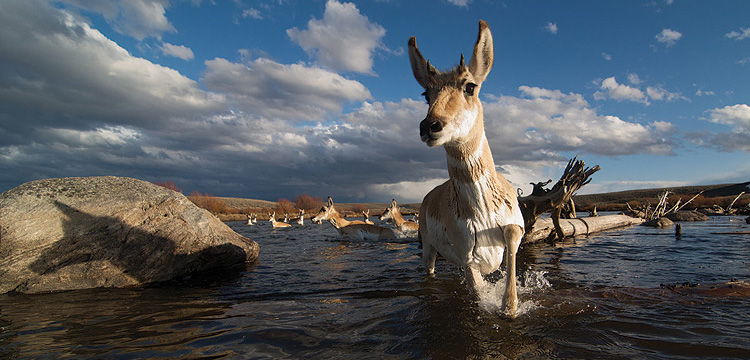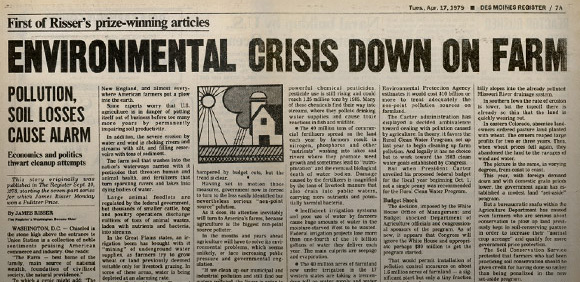
The Bill Lane Center for the American West, Stanford University
Knight-Risser Prize Symposium
Nov. 15 at Stanford: “Houston, You Have a Problem”
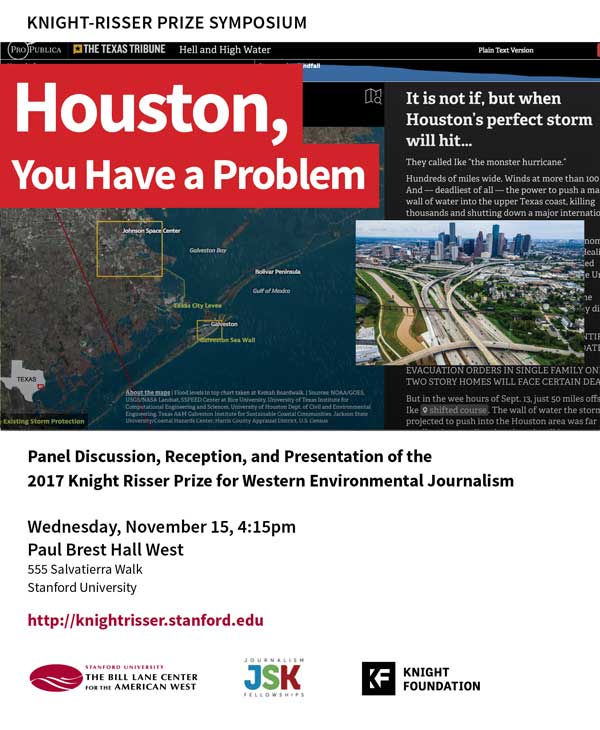
On Nov. 15 we celebrated the 2017 Knight-Risser Prize winners, The Texas Tribune and ProPublica. Their story, “Hell and High Water,” was a deeply reported, interactive project revealing Houston’s severe vulnerability to hurricanes and flooding – and the government’s unwillingness to address the increasingly dire warnings of scientists.
The Texas Tribune and ProPublica Report on Houston’s Flood Vulnerability Wins 2017 Knight-Risser Prize
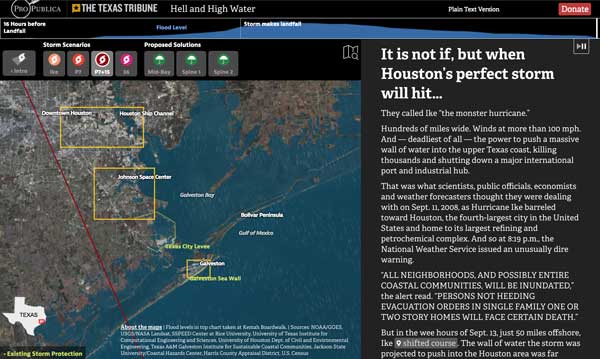 “Hell and High Water,” a joint project of The Texas Tribune and ProPublica, has won the 2017 Knight-Risser Prize for Western Environmental Journalism. The prize goes to Neena Satija, investigative reporter and radio producer for The Texas Tribune and Reveal; Kiah Collier, Energy and Environment Reporter for the Texas Tribune; Ryan Murphy, Senior Designer/Developer for The Texas Tribune, and ProPublica’s News Application Developers Al Shaw and Jeff Larson.
“Hell and High Water,” a joint project of The Texas Tribune and ProPublica, has won the 2017 Knight-Risser Prize for Western Environmental Journalism. The prize goes to Neena Satija, investigative reporter and radio producer for The Texas Tribune and Reveal; Kiah Collier, Energy and Environment Reporter for the Texas Tribune; Ryan Murphy, Senior Designer/Developer for The Texas Tribune, and ProPublica’s News Application Developers Al Shaw and Jeff Larson.
The judges also gave Special Recognition citations to the Oregonian series “Toxic Armories,” and “The Toxic Air Latinos Breathe” by Univision Noticias.
The award will be presented at the annual Knight-Risser Prize Symposium at Stanford University on November 15. More details and registration info are now available.
The 2017 Knight-Risser Prize is Now Closed for Entries
The period for entering 2016 work for the Knight-Risser Prize for Western Environmental Journalism ended on March 15.
We look forward to spending time with all of the entries, and will be back later this year with news about the winners and the annual Knight-Risser Prize Symposium at Stanford University.
If you're interested in submitting 2017 stories for the next round of the competition, download a calendar reminder for when the 2018 competition opens.
2017 Knight-Risser Prize Symposium at Stanford
‘When the Well Runs Dry’ — Assessing the Future of Groundwater Resources
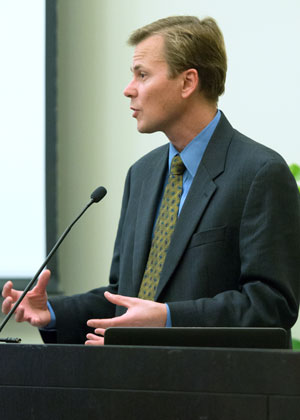 The reporter Ian James talked about the Desert Sun and USA Today’s prize-winning series, “Pumped Dry,” on the looming groundwater crisis in many parts of the world. Joining him at the 2017 Knight-Risser Prize Symposium was a panel of western water experts and journalists.
The reporter Ian James talked about the Desert Sun and USA Today’s prize-winning series, “Pumped Dry,” on the looming groundwater crisis in many parts of the world. Joining him at the 2017 Knight-Risser Prize Symposium was a panel of western water experts and journalists.
Desert Sun/USA Today Exploration of Groundwater Overuse Wins 2016 Knight-Risser Prize
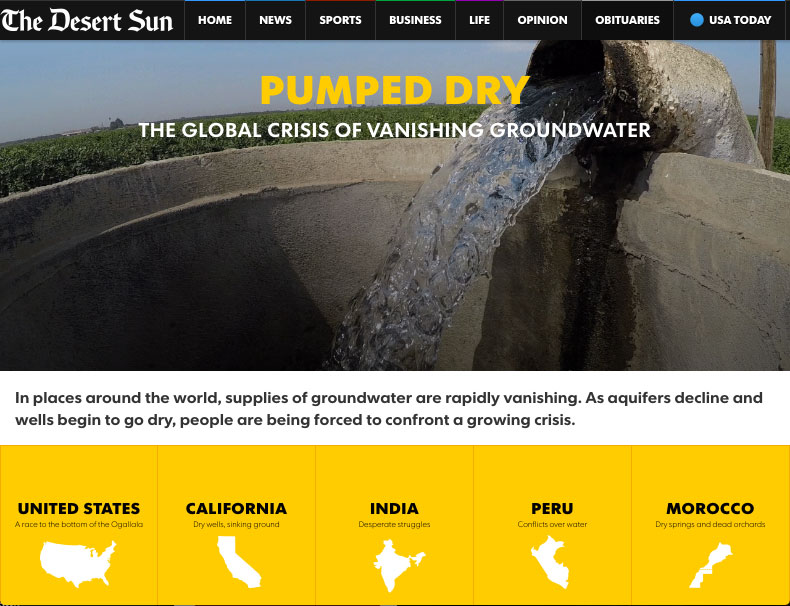 “Pumped Dry: The Global Crisis of Vanishing Groundwater,” a joint project of The Desert Sun and USA Today, has won the 2016 Knight-Risser Prize for Western Environmental Journalism. The prize goes to Desert Sun reporter Ian James, USA Today’s Steve Elfers, a videojournalist, and Steve Reilly, a reporter and data specialist. The judges also gave a Special Recognition citation to the ProPublica series “Killing the Colorado.”
“Pumped Dry: The Global Crisis of Vanishing Groundwater,” a joint project of The Desert Sun and USA Today, has won the 2016 Knight-Risser Prize for Western Environmental Journalism. The prize goes to Desert Sun reporter Ian James, USA Today’s Steve Elfers, a videojournalist, and Steve Reilly, a reporter and data specialist. The judges also gave a Special Recognition citation to the ProPublica series “Killing the Colorado.”
The award will be presented at the annual Knight-Risser Prize Symposium to be held at Stanford University at a time still to be announced. More details and registration info will be available soon.
2016 Knight-Risser Prize Symposium
‘Big Oil, Bad Air’ — 50 Years After the Clean Air Act, Pollution Problems Persist
 Respiratory problems are common among adults and children living near active oil wells and natural gas fracking sites. But it’s a hard to prove a link. At the 2016 Knight-Risser Prize Symposium, the journalists Jim Morris and Susan White joined a panel of experts to discuss the challenge of reporting stories like their 2015 Knight-Risser Prize winning investigation “Big Oil, Bad Air.”
Respiratory problems are common among adults and children living near active oil wells and natural gas fracking sites. But it’s a hard to prove a link. At the 2016 Knight-Risser Prize Symposium, the journalists Jim Morris and Susan White joined a panel of experts to discuss the challenge of reporting stories like their 2015 Knight-Risser Prize winning investigation “Big Oil, Bad Air.”
Investigation into Fracking and Air Pollution Wins 2015 Knight-Risser Prize
 We are pleased to announce that ‘Big Oil, Bad Air’,” a joint investigation by The Center for Public Integrity, InsideClimate News and The Weather Channel has been named winner of the 2015 Knight-Risser Prize. Please join us in congratulating the team of Jim Morris, Lisa Song, David Hasemeyer, Susan White, Greg Gilderman, and all of their colleagues. The judges also gave a Special Recognition citation to the story "Warehouse Empire," by Jessica Garrison of BuzzFeed News.
We are pleased to announce that ‘Big Oil, Bad Air’,” a joint investigation by The Center for Public Integrity, InsideClimate News and The Weather Channel has been named winner of the 2015 Knight-Risser Prize. Please join us in congratulating the team of Jim Morris, Lisa Song, David Hasemeyer, Susan White, Greg Gilderman, and all of their colleagues. The judges also gave a Special Recognition citation to the story "Warehouse Empire," by Jessica Garrison of BuzzFeed News.
The award will be presented at the annual Knight-Risser Prize Symposium to be held at Stanford University in early 2016. More details and registration info will be available soon.
2015 Knight-Risser Prize Symposium
‘Sea Change:’ An Experiment in Multimedia Reporting on a Grand Scale
 At the 2015 Knight-Risser Prize Symposium, journalists and scientists discussed the challenge of explaining slow-moving environmental changes in an impactful way. Exhibit A: The Seattle Times’ prize-winning series “Sea Change,” which explored ocean acidification, the lesser-known twin of global warming.
At the 2015 Knight-Risser Prize Symposium, journalists and scientists discussed the challenge of explaining slow-moving environmental changes in an impactful way. Exhibit A: The Seattle Times’ prize-winning series “Sea Change,” which explored ocean acidification, the lesser-known twin of global warming.
2015 Knight-Risser Prize Symposium
Stanford Prize Spotlights Western Environmental Journalism
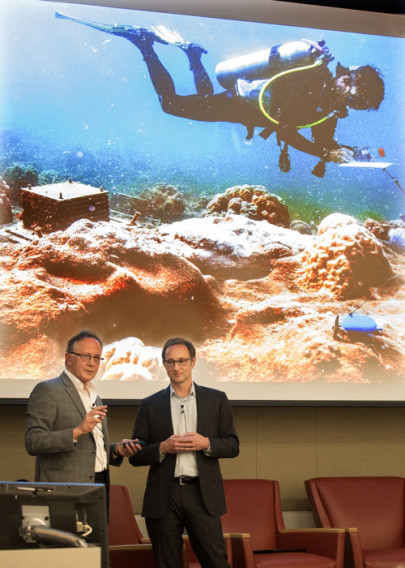 Seattle Times reporter Craig Welch and photographer Steve Ringman traversed the Pacific Ocean – from Papua New Guinea’s coral reefs to Alaska’s king crab fisheries – to see how carbon emissions are changing the ground rules for ocean life.
Seattle Times reporter Craig Welch and photographer Steve Ringman traversed the Pacific Ocean – from Papua New Guinea’s coral reefs to Alaska’s king crab fisheries – to see how carbon emissions are changing the ground rules for ocean life.
PRIZE WINNER Q&A
‘Sea Change’ a Story Driven by Collaboration
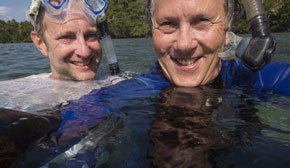 Reporter Craig Welch and photojournalist Steve Ringman interviewed about 150 people for their project “Sea Change,” the 2014 winner of the Knight-Risser Prize for Western Environmental Journalism. But the key to success, they tell the Knight-Risser Prize, was much closer to home – their relationship with each other.
Reporter Craig Welch and photojournalist Steve Ringman interviewed about 150 people for their project “Sea Change,” the 2014 winner of the Knight-Risser Prize for Western Environmental Journalism. But the key to success, they tell the Knight-Risser Prize, was much closer to home – their relationship with each other.
Welch and Ringman will join a panel discussion at the Knight-Risser Prize Symposium at Stanford University on February 25. Register now to attend.
Seattle Times’ ‘Sea Change’ Wins 2014 Knight Risser Prize for Western Environmental Journalism
 We are pleased to announce that the Seattle Times has been chosen as the winner of the 2014 Knight-Risser Prize for “Sea Change: The Pacific’s Perilous Turn,” a multimedia series about the hazards of rising ocean acidification. Please join us in congratulating the reporter Craig Welch, the photographer Steve Ringman, and the entire Seattle Times team. The judges also gave a Special Recognition citation to the series "Aquifer at Risk," by Ian James and Jay Calderon of The Desert Sun.
We are pleased to announce that the Seattle Times has been chosen as the winner of the 2014 Knight-Risser Prize for “Sea Change: The Pacific’s Perilous Turn,” a multimedia series about the hazards of rising ocean acidification. Please join us in congratulating the reporter Craig Welch, the photographer Steve Ringman, and the entire Seattle Times team. The judges also gave a Special Recognition citation to the series "Aquifer at Risk," by Ian James and Jay Calderon of The Desert Sun.
The award will be presented at the annual Knight-Risser Prize Symposium to be held at Stanford University on February 25. More details and registration info are available now.
2014 Knight-Risser Prize Symposium
New Technologies Bolster Shoe-Leather Journalism
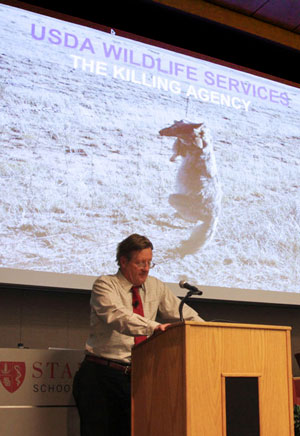 What is the state of investigative reporting in an era of limited resources and crackdowns on confidential sources? The 2014 Knight-Risser Symposium brought together a panel of journalists and scientists to consider this and other questions raised by the 2013 prize winner, "A Killing Agency," which shed light on the little-known federal animal control organization Wildlife Services.
What is the state of investigative reporting in an era of limited resources and crackdowns on confidential sources? The 2014 Knight-Risser Symposium brought together a panel of journalists and scientists to consider this and other questions raised by the 2013 prize winner, "A Killing Agency," which shed light on the little-known federal animal control organization Wildlife Services.
The Sacramento Bee is Winner of 2013 Knight-Risser Prize for Western Environmental Journalism
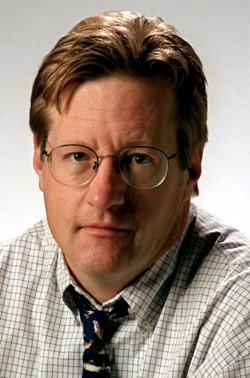 We are pleased to announce that the Sacramento Bee has been chosen as the winner of the 2013 Knight-Risser Prize for "The Killing Agency," a series about a little-known U.S. Department of Agriculture agency whose strategy for controlling animals has killed millions of predators and other species across the West.
We are pleased to announce that the Sacramento Bee has been chosen as the winner of the 2013 Knight-Risser Prize for "The Killing Agency," a series about a little-known U.S. Department of Agriculture agency whose strategy for controlling animals has killed millions of predators and other species across the West.
The judges also gave a Special Recognition citation to the series "Clean Water: The Next Act," a collaboration of InvestigateWest and Oregon Public Broadcasting's EarthFix.
2013 Knight-Risser Prize Symposium
Technology and Up-Close Reporting Help Environmental Stories Make a Difference
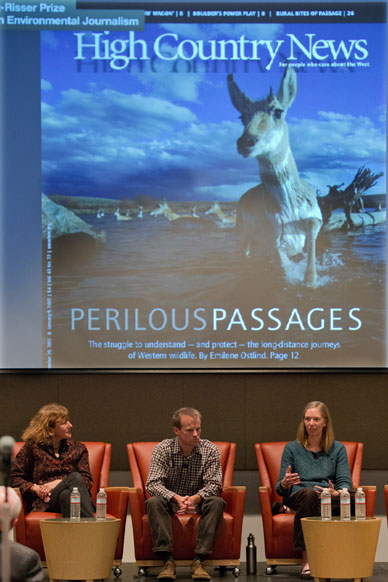 How is technology changing wildlife reporting? The 2013 Knight-Risser Symposium brought together a panel of journalists and scientists to consider this and other questions raised by the 2012 prize winner, "Perilous Passages," which chronicled the epic migration of pronghorn antelope in Wyoming.
How is technology changing wildlife reporting? The 2013 Knight-Risser Symposium brought together a panel of journalists and scientists to consider this and other questions raised by the 2012 prize winner, "Perilous Passages," which chronicled the epic migration of pronghorn antelope in Wyoming.
Pronghorn Migration Story by High Country News Magazine Wins the 2012 Knight-Risser Prize
Judges have awarded the 2012 Knight-Risser Prize for Western Environmental Journalism to "Perilous Passages," a High Country News report by Emilene Ostlind, photographer and biologist Joe Riis, and contributors Mary Ellen Hannibal and Cally Carswell. Including graphics, maps, video, and striking nature photography, the report gives readers a first-hand view of the pronghorns' journey along a 120-mile route through Wyoming that is studded with obstacles, from roads and fences to the region's booming natural gas fields.
The award will be presented at a Knight-Risser Prize Symposium to be held in 2013. More details will be coming soon on the symposium.
The judges also gave a Special Citation to Lynda Mapes and her colleagues at The Seattle Times for "Elwha: The Grand Experiment," about the largest dam-removal project in the history of North America.
2012 Knight-Risser Prize Symposium
Panelists Weigh the Challenge for Journalists: How to Engage Readers on Complex Water Issues
 The Knight-Risser Symposium on January 25 brought together a distinguished group of journalists and scholars to consider how to broaden the reach of environmental journalism in a time of growing threats to western communities.
The Knight-Risser Symposium on January 25 brought together a distinguished group of journalists and scholars to consider how to broaden the reach of environmental journalism in a time of growing threats to western communities.
Read a recap of the symposium with full video and audio of the proceedings.
Denver's 5280 Magazine Wins 2011 Knight-Risser Prize
"Dry Times," a comprehensive report in Denver's 5280 magazine on state water shortages, is the winner of the 2011 Knight-Risser Prize for Western Environmental Journalism. The authors, Natasha Gardner and Patrick Doyle, will receive $5,000 at The Knight-Risser Prize Symposium on January 25, 2012 at Stanford University. The symposium will be dedicated to the topic of journalism and western water issues.
Prize judges also gave Special Citations of recognition to David Wolman for "Accidental Wilderness," published in High Country News, and Julia Scott, Sasha Khokha and Christopher Beaver for "Nitrate Contamination Spreading in California Communities," distributed by KQED Radio and California Watch.
Knight-Risser Prize and Symposium Are Permanently Endowed
Thanks to you, we've established a permanent endowment to reward, showcase and inspire environmental journalism in the West. Your generous contributions have matched the John S. and James L. Knight Foundation's 2:1 challenge grant, and secured $300,000 to permanently endow the prize and symposium.
We want to take a moment to salute the people whose generous support was instrumental in endowing the prize.
The 2011 Knight-Risser Prize is Now Closed for Entries
The period for entering 2010 work for the Knight-Risser Prize for Western Environmental Journalism ended at midnight, Hawaii time on March 16. We are grateful to all of the organizations and individuals who submitted their work for the inaugural year of our revamped program. We're excited at the range of great environmental reporting that we are seeing in the entries, as well as the signs of journalism innovation that is part of our new, expanded focus.
We look forward to spending time with all of the entries, and will be back later this year with news about the winners and the annual Knight-Risser Prize Symposium at Stanford University.
We would also like to take this time to thank the John S. and James L. Knight Foundation for their generous support of the prize and symposium, and to all the friends of the prize who contributed to the Knight Foundation's 2:1 match. We are close to the finish line, and hope that we can get tax-deductible contributions in any amount to help us over the top. For more information, please see our donation page. And thanks!
2011 Knight-Risser Prize Symposium
Report on Knight-Risser Symposium: "The Crisis in Environmental Watchdog Journalism"
We've published a recap of this year's Knight-Risser Prize Symposium, "The Crisis In Environmental Watchdog Journalism," held at Stanford Nov. 17, one of the highlights being Prize winner Lewis Kamb's announcement that he'll be contributing part of his winnings to a new nonprofit cooperative, Investigate West..
If you'd like to join Lewis in supporting Investigate West, you can contribute on their site. There's also still time to participate in our endowment drive, where your contributions to the Knight Risser Prize will be matched 2:1 by the Knight Foundation!
Lewis Kamb and the Seattle Post-Intelligencer Are Named Winners of 2010 Knight-Risser Prize
Knight Foundation Pledges Matching Grant to Endow Environmental Journalism Prize
2010 Knight-Risser Prize Symposium
January 2010 Symposium: “Visualizing the Environment”
John S. Knight Fellowships
For Seattle Times journalist Hal Bernton, a picture turned out to be worth more than a thousand words. It kicked off an investigation into the link between logging permit practices and a storm’s extraordinary devastation. And the graphic “visualization” the team went on to produce was worth a million.
The photo was one of a few aerial shots photographer taken by Steve Ringman. It showed the top of a mountain with nearly all its soil swept away, the extreme denuding the result of a monstrous rainstorm in 2007 – and, clear-cutting on the forest top.
Texas Tribune, ProPublica

The Desert Sun and USA Today

CPI, InsideClimate News, The Weather Channel

The Seattle Times

The Sacramento Bee

High Country News

5280 Magazine

Seattle Post-Intelligencer

What Went Wrong?
The Seattle Times

San Antonio Express-News

The Los Angeles Times

High Country News





